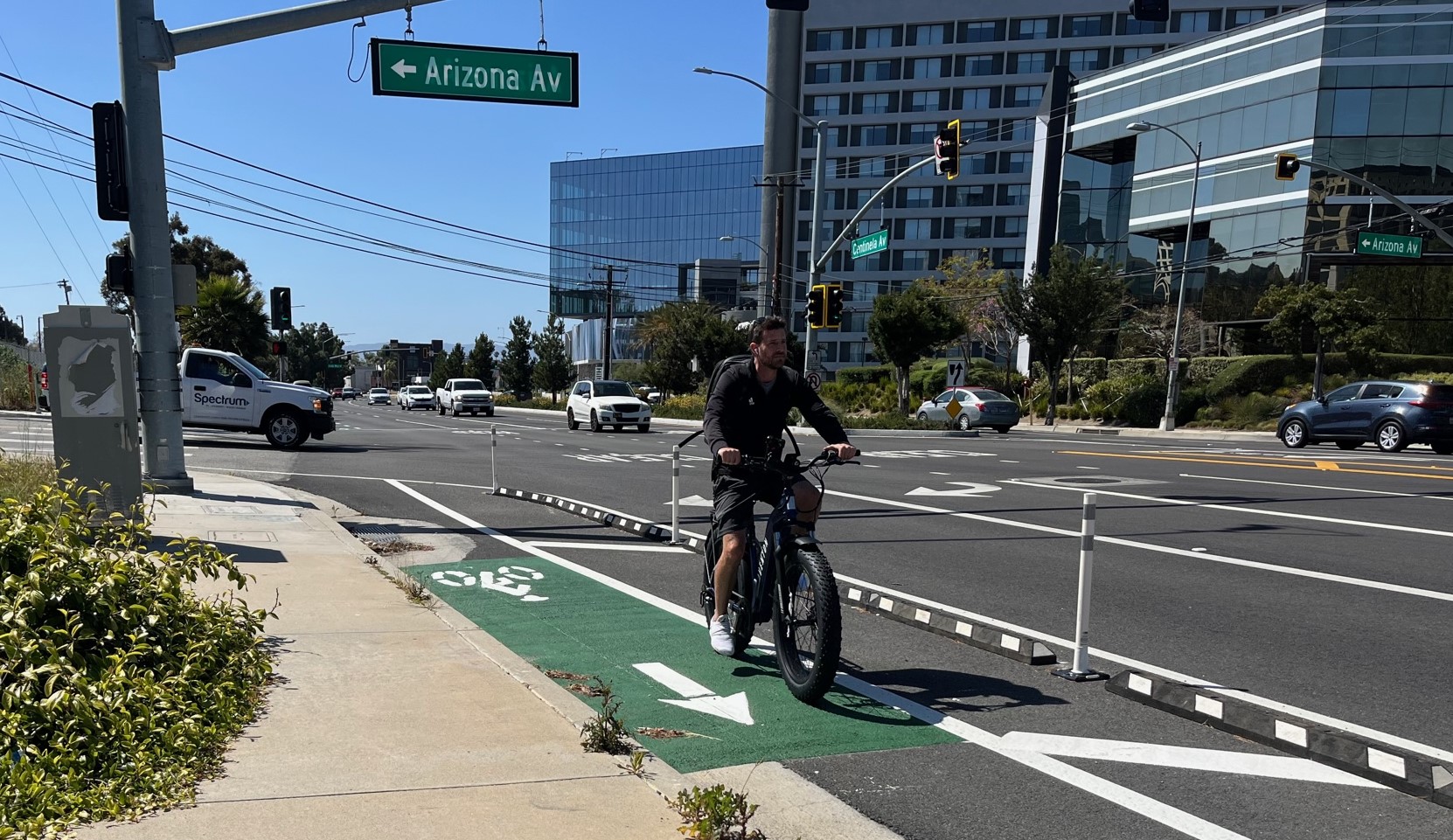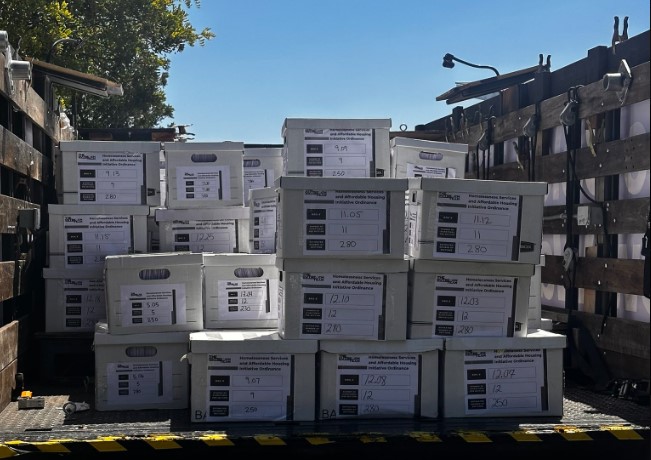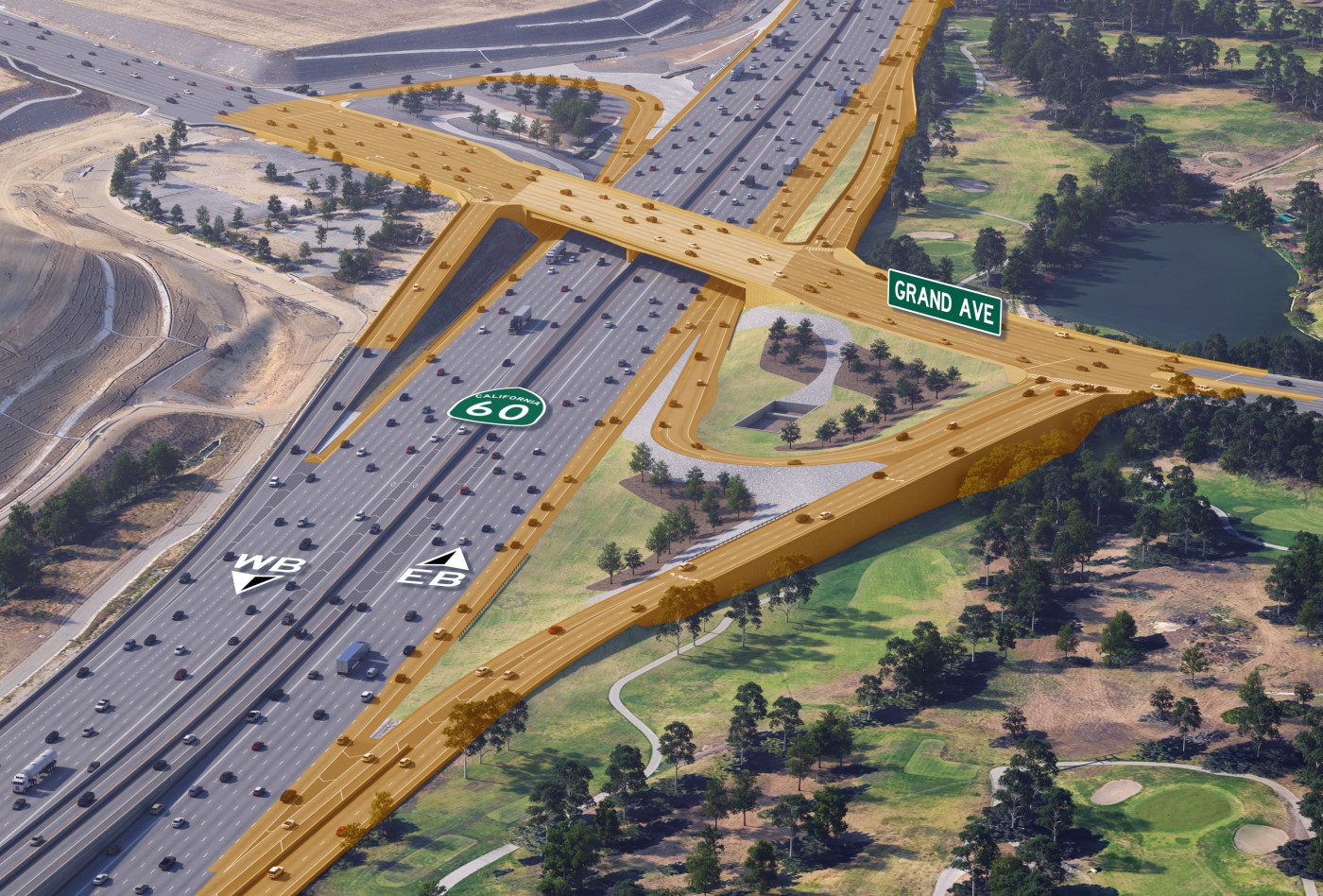“The Car Culture that We Have Is Not Promoting Life:” Riders Gather to Remember Frederick “Woon” Frazier
5:53 PM PDT on April 16, 2018
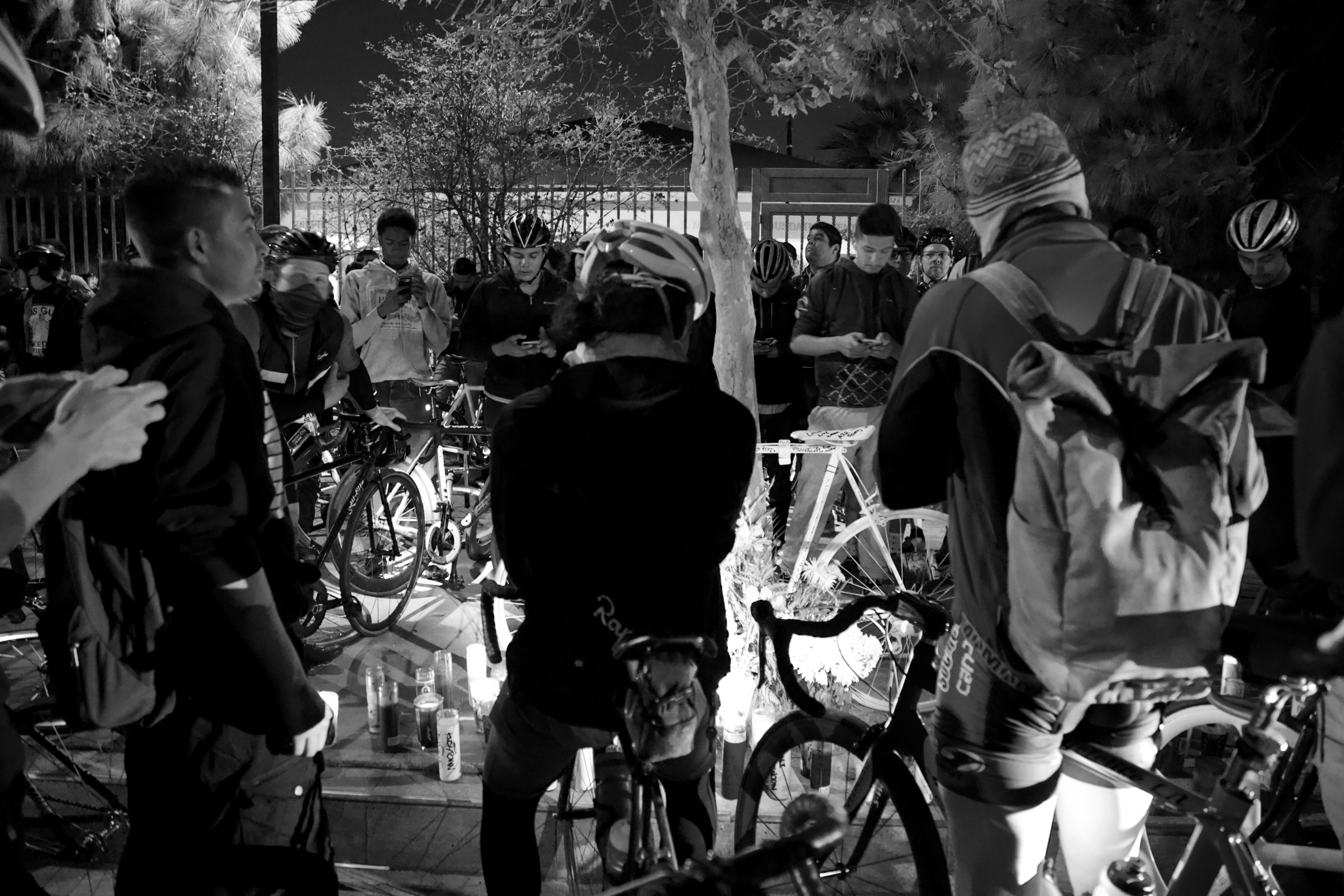
Friends of Frederick “Woon” Frazier and fellow cyclists gather around the ghost bike placed near the site where he was run down just a few days prior. Sahra Sulaiman/Streetsblog L.A.
"The culture right now in L.A. - the car culture that we have - is not promoting life," said Edin Barrientos to the approximately 150 cyclists gathered to remember Frederick "Woon" Frazier, the 22-year-old cyclist who was mowed down in a vicious hit-and-run just a few days before.
They were standing just east of Normandie, on Manchester, at the spot where Frazier had been run down just three days earlier. They had ridden down from Hoover and 25th, the meet-up spot for the Monday night Chief Lunes rides Frazier had participated in.
Barrientos, the founder of Chief Lunes - one of several weekly rides where young, mostly black and brown cyclists gather to reclaim space, feel validated, build their strength, and build community - was determined not to let this rare moment that the city was actually paying attention to street safety pass.
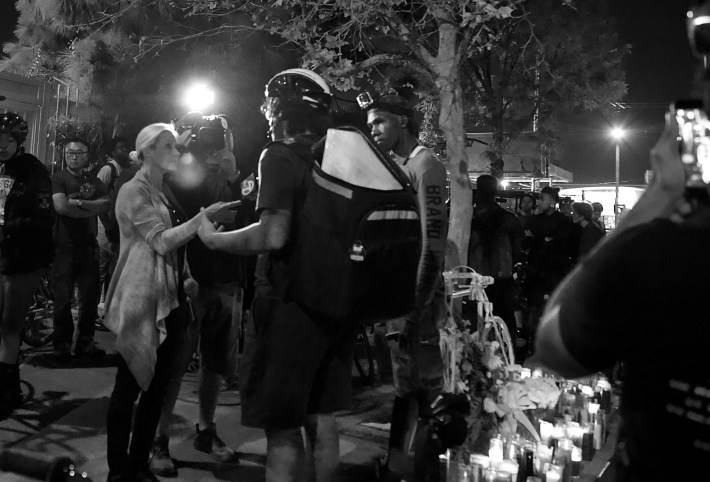
"It's not safe for anyone to be on the streets right now, man," he told the crowd. "I feel - just as you guys - a lot of anger, a lot of fear, a lot of sadness for our friend that passed away, you know. I really do."
"I think we all have a voice," he continued, gesturing towards the cyclists gathered around the ghost bike. "And nothing's going to happen until you step up. If we're not stepping up to city hall, to city officials, to the police, to the media, to the public about these issues, nothing is going to happen and someone else is going to die. Someone closer to you guys is gonna pass away. Someone is going to get killed. They don't care about us. The laws that are in effect are not about keeping cyclists safe on the streets."
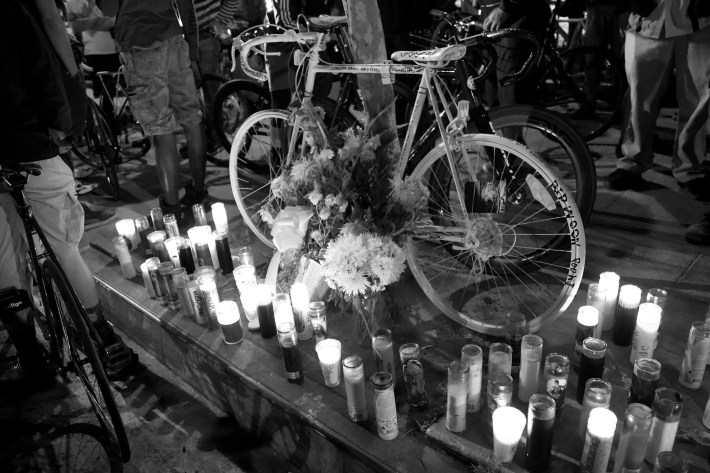
Barrientos was referring to the recent crashes that the group had also mourned - 54-year-old Elisa Gomez, run over by a FedEx truck in a hit-and-run at Long Beach and Washington, and 15-year-old Sebastian Montero killed two weeks ago in Woodland Hills. What he didn't know was that just as cyclists began gathering at Hoover Park for Frazier's memorial ride, a pedestrian was killed at Figueroa and Imperial Highway. Or that later that night, a man in a wheelchair would be killed at Century and Main. Or that yet another cyclist would be run down at Century and Avalon the following night.
And while the sheer frequency with which bodies seemed to be piling up was shocking enough on its own, seeing the photos of Woon's broken body laying in the street and then watching one of their own be slammed into and tossed in the air in front of them at the vigil last Wednesday lent even greater urgency to the group's interest in seeing a change to the deadly status quo.
It was devastating to see the extent to which Frazier's bones had been shattered, the force with which his head must have slammed into the ground, and the amount of blood that he had lost and to also know that the person who caused all that damage saw all of that, too, and heartlessly kept driving.
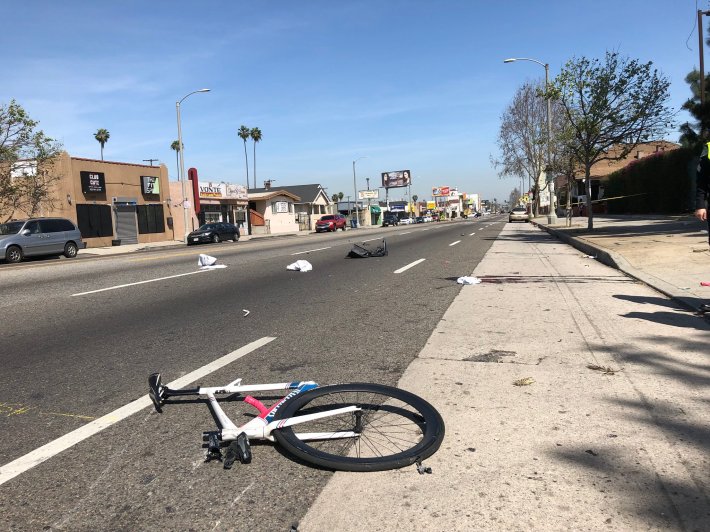
And it was made all the more difficult to swallow by the fact that Frazier had been one of the strongest among them.
He'd been a big guy when he started riding over eight years ago, friends Christian Dominguez and Devon W said, but he had dropped weight and gotten in shape fast. Next thing they knew, they were all struggling to keep up with him.
"He was a legend in the streets," smiled Devon.
And he was also a good friend.
Keiven Muñoz was still trying to process the loss at the end of the memorial ride Friday night, as the mourners pulled up in front of city hall.
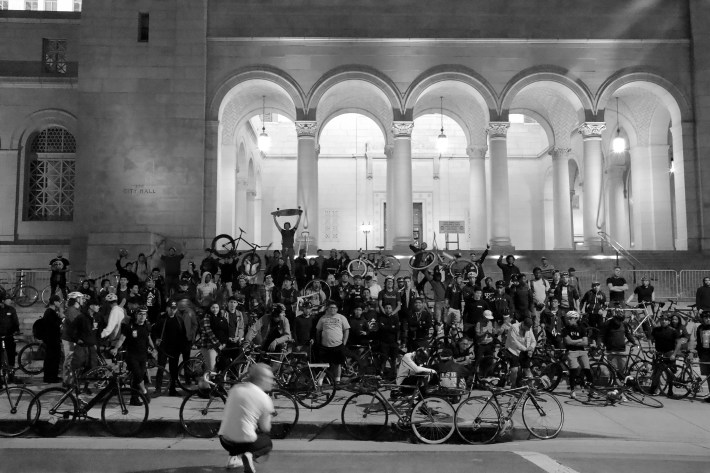
They had met because Muñoz had sold him bike parts. Their friendship had developed from there. It made him proud to know that Frazier was out riding races with parts that he had contributed, he said. In return, Frazier stoked Muñoz' passion for cycling.
Frazier always knew Muñoz had his back, he said - whether Frazier needed someone to listen or whether he got a flat in the middle of the night and needed help, Muñoz always answered the call.
He had first gotten word of Frazier's death in a facebook group chat, he said. Frazier was supposed to meet up with some of the crew to ride, but he hadn't showed. When Muñoz saw the blurry image of Frazier's body first appear on his phone, he said, "My heart instantly dropped and I just broke down."
His instinct was to head over to Frazier's home to comfort his mother. Although they hadn't met before, Muñoz says, she instantly recognized him and wrapped him up in a huge warm hug. "I just started tearing down," he said of meeting her. "He was her only son."
"I'm lost for words," he said, trying to summarize how he was feeling now. He'd barely slept over the past few days in between setting up the gofundme and trying to gather as much intel on the incident as possible. "I keep thinking about him."
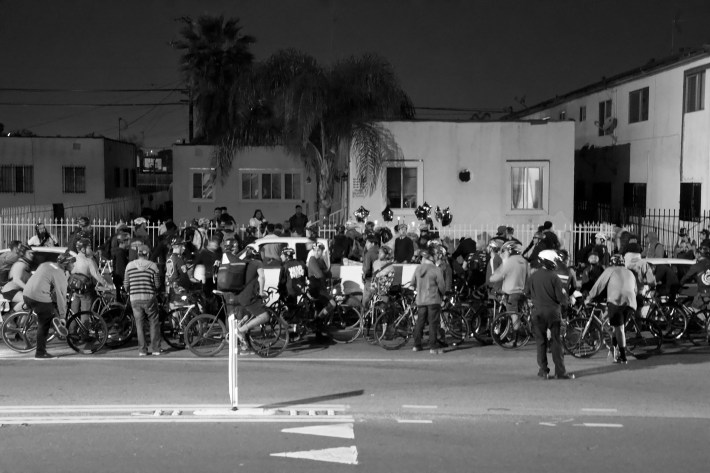
Muñoz wasn't the only one concerned about Frazier's mother.
Devon said he had stopped by with flowers. Christian Dominguez had helped put together memorial decals he and Muñoz were selling at the event to help raise money for Frazier's funeral. And the riders made a pit stop at her home, located just blocks south of where he was killed, to listen in silence as she talked about her loss and what having their support meant to her.
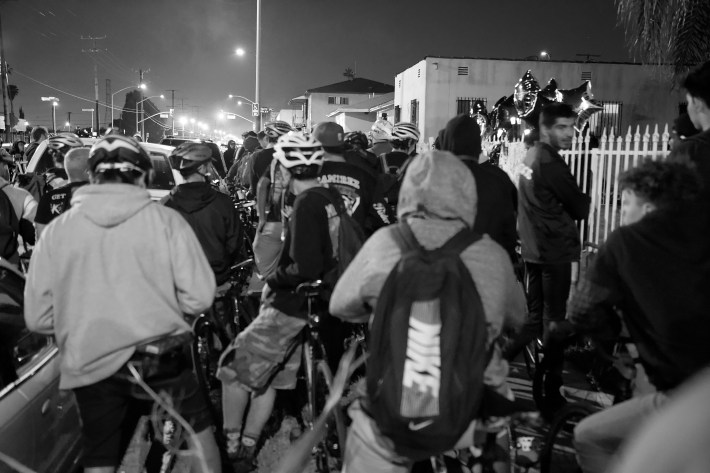
As the riders rolled down Normandie toward her home, people called out, "Are you riding to protest?"
And even though it was late, neighbors who saw the cyclists roll up came out of their apartments to call out, "God Bless!"
Everyone in the area knew Frazier, had seen him riding in the streets, or knew his family.
It was a community-level loss. And it was one that the community had least expected.
It was the first friend of his who hadn't died as a result of neighborhood violence, said a young man who originally hailed from Chicago. His words echoed those of another friend's facebook comments on the news of Frazier's death, "At least it wasn't a bullet..."
The community where Frazier comes from is a tough one for young men.
"You can feel suffocated at home," said Dominguez.
Frazier worked in security at LAX. But unemployment and underemployment for black men is at levels matching those of the 1992 uprising, the epicenter of which lies just a dozen blocks north of where Frazier was killed. Disinvestment has denied the community recreational resources and venues for entertainment for youth, while disenfranchisement and repressive policing have fueled the entrenchment of gangs and limited residents' access to their own streets in many neighborhoods.
Fixie riding can act as a kind of inadvertent disenfranchisement hack - a way to signal to area gangs that they roll their own way and a way to signal to cops that they're not, as police often view youth on bikes in gang territories, a gang lookout or someone planning to commit a crime. It doesn't mean they won't still be hassled by both - they often are - but it gives them a bit more control over their own destiny.
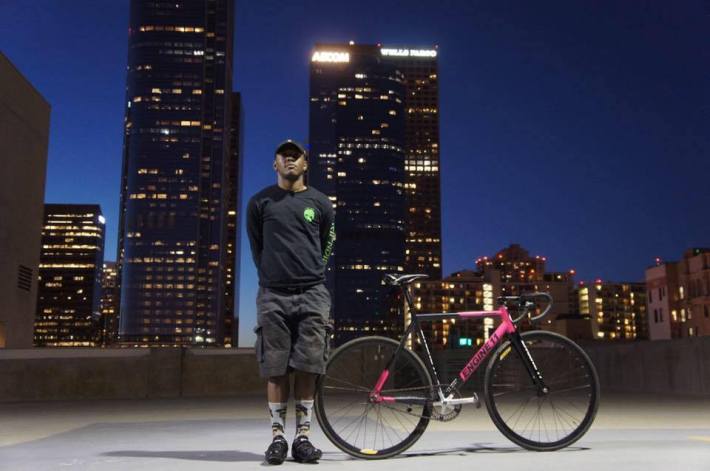
And taking to the streets with a crew gives them a way to see the city (especially for those who have no other form of transportation), a family of riders who come from similar circumstances, something they can take pride in, and an activity that makes them feel like they're part of something bigger than themselves.
Now having conducted more memorial rides than they cared to count, however, they seemed to collectively realize that that "bigger thing" might also involve tangible changes to the very streets they roll through.
"Not everyone can get to the velodrome to ride," said Steven Ramírez, who had recently had his own nose broken in a hit-and-run in Echo Park. "In South Central, we have the streets."
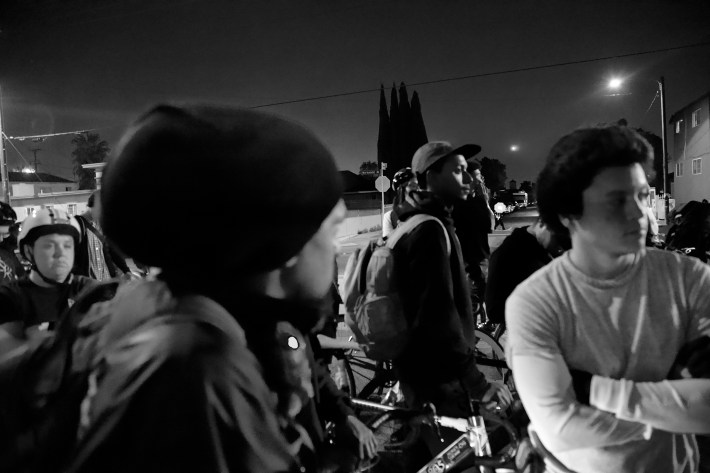
Their first go at raising their voices didn't go so well.
As we all saw last Wednesday, a peaceful corking of an intersection turned into chaos when an officer drove into the crowd of bicyclists and knocked into some of them (including possibly running over a bike, according to a few eyewitness accounts), the cyclists retaliated by beating on the vehicle, and then a driver (who had only minutes earlier gotten out of her car and punched a female cyclist) returned to the intersection and deliberately plowed into Quatrell Stallings, tossing him high into the air and breaking several of his bones.
It wasn't how they had planned for things to end, lamented Muñoz.
He had helped organize the vigil and had thought the cyclists would stay on the sidewalk. In their trauma, grief, and anger, however, they spontaneously spilled out into the intersection chanting, "Long live Woon!"
All he could do was watch in horror as the rest of the scene unfolded. He had yelled at Stallings to get out of the way when he realized the driver of the gold Toyota had turned back around and was heading straight into his friends. But the next thing he knew, Stallings was flying through the air.
Police interviewed regarding the incident that afternoon were already framing the cyclists as the aggressors and the hit-and-run driver as a potential victim. [They have since found the car used to hit Stallings and released a photo of a driver, although the driver herself still remains at large.]
Meanwhile, Muñoz was wasn't the only member of the crew who was still confused about how things had turned so bad so quickly or who was unhappy about the outcome.
But they also realized that the fact that it was all caught on camera had made what otherwise was yet one more tragic hit-and-run front page news.
At the Friday night vigil, they rallied their crews to stand up and be heard.
Moses Williams - who had considered Frazier a brother - spoke of the heartbreak of realizing why his brother hadn't shown up to their planned meet-up Tuesday and of texting his deceased friend Friday morning, hoping it was all a bad dream.
Speaking to the news crews he hoped were recording his words, he implored drivers to make space for others on the road.
"We are people. We have hearts and souls. We walk. Just because you're in a car, you can't treat us any type of way. You guys have engines. We don't ... We can't speed up like you can ... We have one lane and if that one lane is taken up, we have to make our own lane. Woon made his lane the gutter lane. He didn't choose to go into oncoming traffic, in the driving lane. Woon was smart. He chose to go into the gutter lane, which is technically the bike lane - everyone knows that."
"But the person who hit him obviously didn't and felt the need to jump to the gutter lane and try to gun it," he continued. "And it wasn't fair to Woon."
Saying that he was still in denial over events, he tried to speak to the humanity of those that might be listening. "Let's make this an issue for city hall. Bike lanes need to be created ... because we don't have the ability to get hit by a car and jump back up as they think we do. It's not something that we can do. We're not superhumans. We're humans just like them. That person in that car is just like us. They're no different from us."
"Make it an issue for city hall," Williams said again. "Let it be known what happened to Woon."
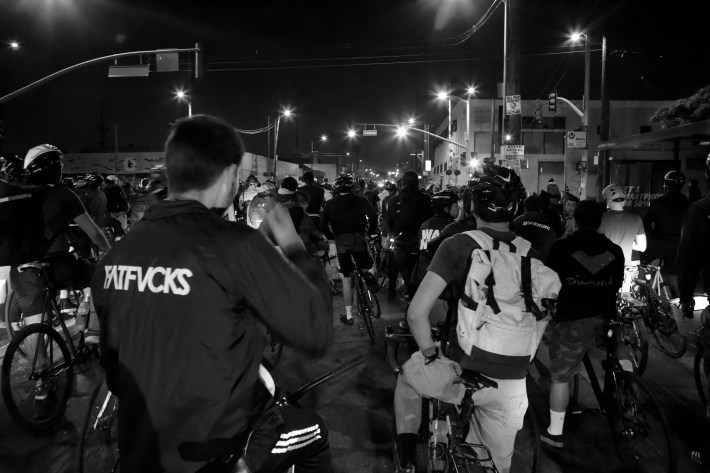
The cyclists are still deciding what their next steps might be.
Because of the extent to which so many of their neighborhoods have been neglected, the idea of engaging their city government is both new and overwhelming for most. And because the planning apparatus is as opaque as it is to those that don't know all the right planning jargon, there will likely be a bit of a learning curve involved.
But they are determined. They'll be meeting up for the regular Chief Lunes ride tonight to talk more about next steps and will continue the conversation tomorrow, at a press conference Muñoz says the LAPD plans to hold at Manchester and Normandie at 2 p.m.
Let it be known, as Williams said, that they are tired of the carnage and are putting city hall on notice.
Let it be known.
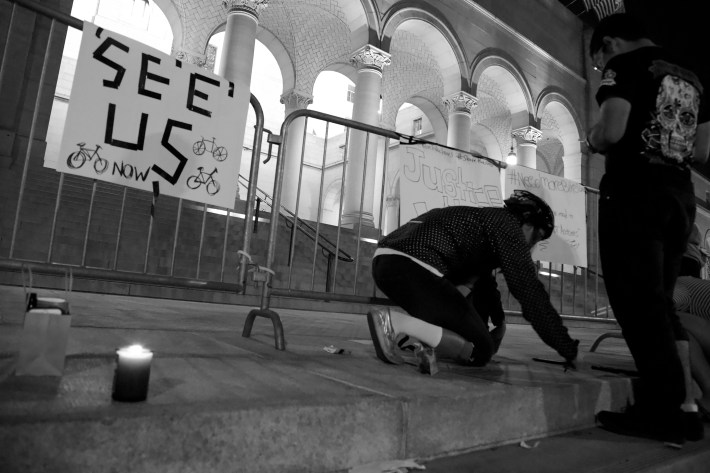
Sahra is Communities Editor for Streetsblog L.A., covering the intersection of mobility with race, class, history, representation, policing, housing, health, culture, community, and access to the public space in Boyle Heights and South Central Los Angeles.
Read More:
Stay in touch
Sign up for our free newsletter
More from Streetsblog Los Angeles
Eyes on the Street: Recent Centinela Bike Lanes in Culver City
The new partially-protected Centinela facility is a welcome safety upgrade for a stretch that long lacked any type of bikeway, but the area remains not all that bike-friendly
This Week In Livable Streets
Bike Month continues, Metro 91 Freeway widening, Destination Crenshaw, Culver City Bus, Santa Monica MANGo, Metro bike lockers, Metro Sepulveda Transit, and more
San Fernando Valley Bus/Bike Updates: G Line, Roscoe Bus Lanes, Laurel Canyon Bike Lanes
Short newly protected bike lane on Laurel Canyon Blvd, extensive NSFV bus improvements under construction this month, and scaled-back G Line plans should get that project under construction this summer
